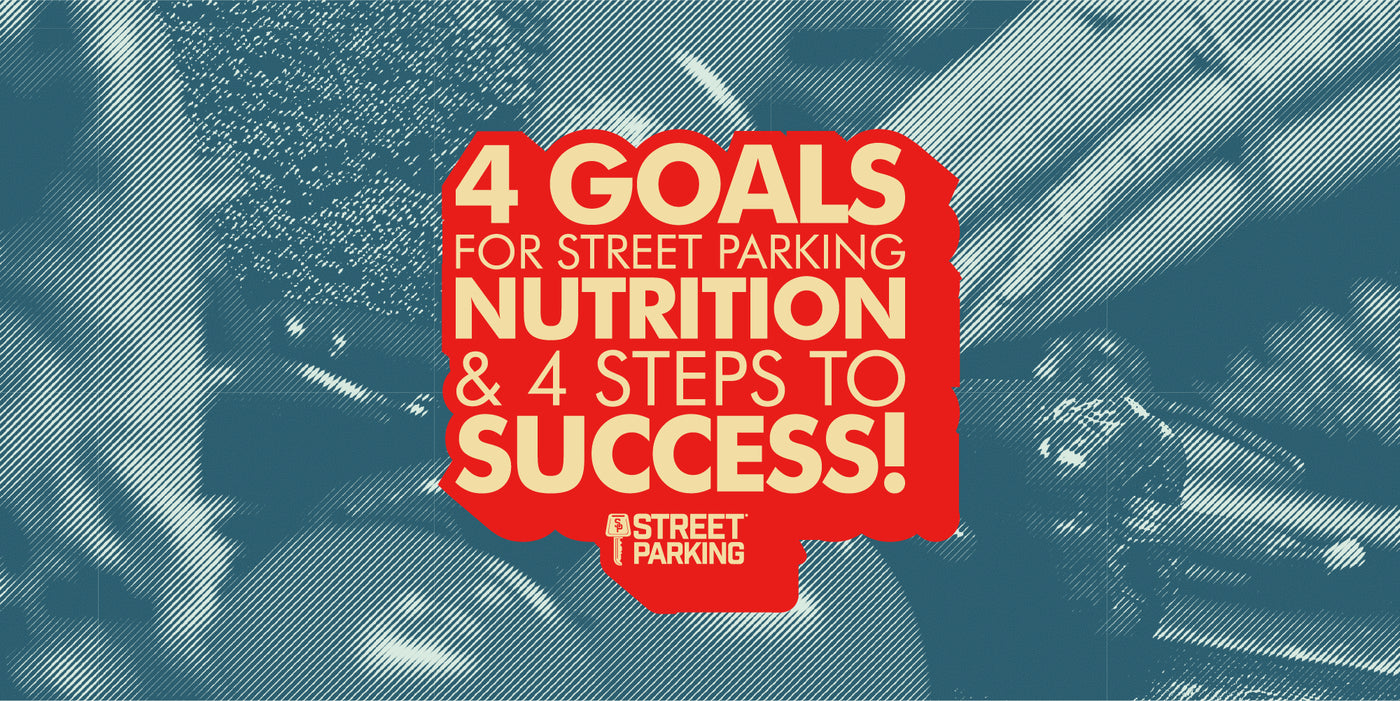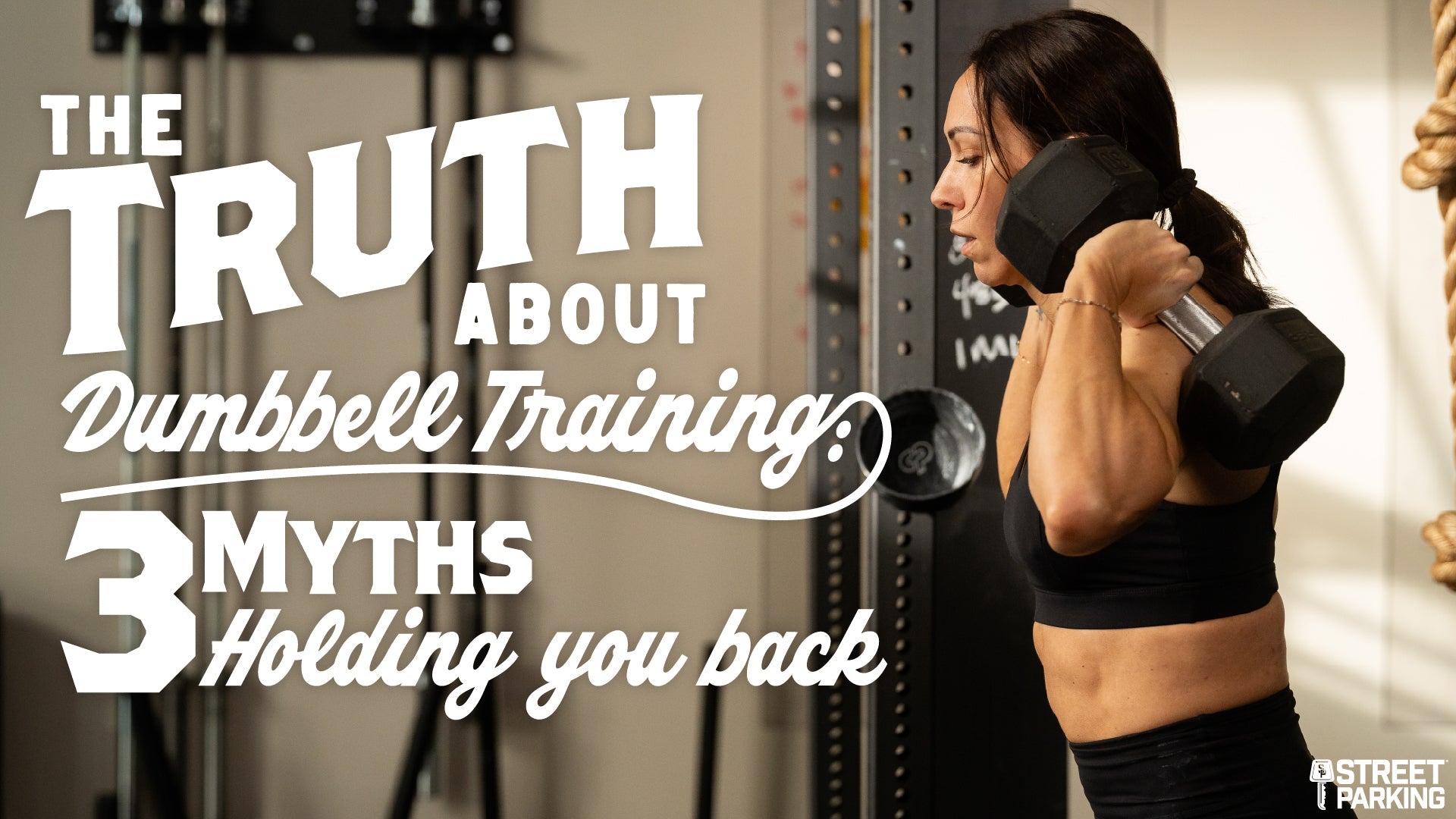
“A lifelong nutritional approach should deliver results in our overall health and body composition, fuel our lifestyle, be sustainable, and enjoyable.”
When it comes to nutrition, Street Parking has four goals for our members:
- Balanced macronutrient intake across protein, carbohydrates, and fat.
- Encourage eating the healthy, unprocessed foods our bodies are designed to eat.
- Encourage portions and daily intake that is appropriate to fuel performance and sustain energy levels while providing a positive impact on our overall body composition.
- Create a lifestyle that is simple, enjoyable, flexible, and sustainable.
In our last blog post “4 Ways to Evaluate Your Nutrition,” we gave you a short quiz you can apply to any diet or way of eating to determine if that approach will work for you at every level. Not just if the approach will deliver results, like weight loss or strength gains, but how it might impact your overall health or whether it is sustainable for the long haul.
- How will this approach impact my body composition?
- How will this approach impact my overall health?
- How will this approach impact my performance?
- Is this approach sustainable for LIFE?
In reality, there is no “one right way” to tackle nutrition and check all of the boxes for those four questions. We all have different goals, lifestyle factors, and even food preferences that impact the nutritional approach that we may ultimately choose.
Just as Street Parking encourages “Fitness Freedom” (and therefore offers various types of fitness programs to follow), we believe there is a lot of freedom that can be applied to how we eat.
The following are a few approaches to balance and measurement that we have seen work very well time and time again, and they are SIMPLE and SUSTAINABLE for most people in most situations. For us, this approach to finding precision and plugging in the right foods checks all of the boxes! We encourage you to start with the most basic one first, and over time, work your way through the others.
Chances are just taking the very first and most simple approach — done with consistency — is all you may ever need to find your sweet spot for lifelong health and sustainable results.
A Few Things To Keep In Mind
- All three of the following “measurement” styles are meant to be done and will produce the best results with whole/unprocessed foods. That means you don’t need a food label to know what it is. An apple is an apple. A steak is a steak. A sweet potato is a sweet potato. No need to look at an ingredients list.
- Sauces and sweeteners add up. You may do a phenomenal job of getting the portions of food dialed in, but then you find yourself adding sauces and sweeteners to your food that throw off the ratios of proteins, carbs, and fat. Be careful about this!
- Just because something is from a “paleo” cookbook doesn’t mean you can eat as much of it as you want and call it “healthy.” As mentioned in the two previous Unlocked write-ups: CALORIES DO MATTER. Taking healthy foods and trying to make them look like treats is a common mistake that can leave you frustrated and confused.
- You are not expected to say goodbye to your favorite holiday foods or cultural traditions forever! Sticking to whole foods in proper proportions 80-90% of the time with a little wiggle room for the things you love is a huge part of the sustainability of any nutrition approach.
Balancing Protein, Carbs and Fat
Why Protein
Protein is an essential macronutrient, which means that we need a small amount of protein just to survive. And we want to optimize our protein intake in order to thrive.
Protein is a vital macronutrient for so many functions of our body, including:
- Maintaining, growing, and repairing tissue
- Building and maintaining lean muscle mass
- Improving body composition
- Decreasing body fat
- Improving the health of our hair, skin, and organs
- Improve meal satiety (fullness), in turn helping to control total caloric intake
Consuming enough protein can help you to build and maintain muscle mass, for sure. But it will also help prevent too much muscle loss when you are working toward fat loss goals/body composition changes. Adequate protein will also help to reduce the muscle loss commonly associated with aging.
PROTEIN SOURCES
Some examples of protein:
- Meat (poultry, beef, fish, game meats)
- Eggs/egg whites
- Plain Greek yogurt
- Protein powder (though not all are created equal)
WHAT TO WATCH OUT FOR
- Beware of the notion that you can get all of your protein needs from things like nuts and beans. As mentioned, these foods DO contain protein, but they also bring along with them a heavy fat and/or carbohydrate load. This means you will need to eat a LOT of them in order to meet your protein needs and, in turn, would consume a high amount of calories from them in order to consume adequate protein.
- Try to not fill your diet with protein powders. You will feel much more satisfied from your meals by actually chewing your food. Save the protein powders for post-workout or when you are in a pinch.
- Watch out for regularly consuming protein that is heavily covered in sauces or fried — these calories add up!
- If you are struggling to make lean protein sources (like chicken breast) taste good, consider taking a break. Try exploring proteins like chicken thighs, pork tenderloin, and ground beef which are a bit higher in fat. Ground meats like ground turkey or ground chicken are also great options.
ARE THERE VEGETARIAN/VEGAN OPTIONS?
You can certainly hit protein targets for optimal health as a vegan/vegetarian. However, when you're prioritizing the consumption of protein, you want to aim to get whole protein sources as much as possible. Because, yes, that slice of bread has 2 grams of protein in it. But you'd have to eat the whole dang loaf to get remotely close to the amount of protein needed in a single day.
As you are able, consume the highest quality of protein possible. Your options will vary depending if you're vegetarian or vegan.
Some examples of plant-based protein:- Beans, chickpeas, lentils
- Tofu
- Tempeh
- Hemp seeds
- Seitan
Why Carbs
Carbohydrates are the body’s first choice to fuel almost every activity you do. Once they enter the body, they are broken down into glucose (sugar) and absorbed into the bloodstream with the help of insulin. Whether it’s running a marathon or simply just breathing, the body requires glucose for energy. It’s what fuels all of our activities. Carbs also help with brain function, contain essential vitamins, and can help fight heart disease.
CARBOHYDRATE SOURCES
- Starches (complex carbohydrates): they are found in legumes, grains, and starchy vegetables like potatoes, corn, etc.
- Sugars (simple carbohydrates): natural sugars in vegetables, fruits, milk, and honey. Added sugars are found in processed foods, syrups, sugary drinks, and sweets.
- Fiber: plant-based foods such as fruits, vegetables, and whole-grains.
Unfortunately, several fad diets have encouraged us to believe that ALL forms of carbohydrates are “bad” or “fattening” foods. Keep in mind that not all carbohydrates are created equal! What we need to watch out for are the highly processed, sugar-laden carbohydrate foods like cereals, desserts, and sugary drinks. These foods are high in calories and LOW in quality, which often leads to overconsumption.
We recommend filling the majority of your diet with starchy carbohydrates rich in fiber. Then you can incorporate some of the more processed foods that you feel align well with your lifestyle and goals.
Some examples of quality carbohydrates:
- Fruits and vegetables
- Rice
- Potatoes and sweet potatoes
- Beans and legumes
- Whole grains
WHAT TO WATCH OUT FOR
In the 1980s fad diets scared an entire generation into believing that dietary fat was the cause of body fat. The low-fat/no-fat diet craze exploded from there.
The truth is that dietary fats play an essential role in our ability to survive and perform many crucial bodily functions. Fat is a great fuel source and also will improve brain development, overall cell functioning, hormone production and maintenance, protect the body’s organs, and even help you absorb vitamins found in foods.
Fat also helps slow down the digestion of your food which helps with satiety and keeps you feeling full for longer.
Fats ARE more calorically dense than carbs or protein, but when kept in proper portion sizes, they are important for our overall health and will help us to reach our goals and maintain them more effectively!
FAT SOURCES
Some examples of healthier fats:
- Nuts/Seeds/Nut Butters
- Avocados
- Olive oil
- Coconut oil
WHAT TO WATCH OUT FOR
- Many of our favorite protein sources also have a fair amount of healthy fat. The fattier your meat, the less you may need to add to your meals.
- Limit the amount of fried foods you consume. These foods are HIGH in fat and therefore high in overall calories.
Try to avoid cooking with seed-based and vegetable cooking oils (like canola oil) as the specific fatty acids found in processed vegetable oils have been linked to inflammation and chronic health conditions. Instead, swap them out for olive oil, avocado oil, or coconut oil.
4 Steps to Improving the Quality and Precision of Your Foods!
Step #1 - Quality First!
Start by taking a look at WHAT you are eating. This isn’t a call to go buy only organic produce and only consume grass-fed meats that have been blessed by a shaman. But, let’s work toward cutting out the crap — in other words, eat the REAL FOOD our bodies are designed to eat! Avoid processed foods. Build most of your meals and snacks with foods that don’t require a food label for you to know what it is. An apple is an apple. A steak is a steak. A bell pepper is a bell pepper. Avoid foods with a long ingredient list, a long shelf life, and a lot of added sugar.
If you currently eat a lot of processed foods, DO NOT go crazy and try to change every meal at once. Start with one meal per day. When that becomes manageable, try shooting for two meals a day and so on.
- Tip: It can help to categorize foods into “everyday foods” and “sometimes foods.” No food needs to be demonized and cut out completely, but a recognition of foods that should make up most of our meals and others that are better consumed “sometimes” can help us make better food choices. This approach also works really well with kids!
Step #2 - Balance Your Plate
Make sure that your plate at each meal contains all three of our macronutrients: protein, carbohydrates, and fat. Bonus points if you can get a veggie serving in there as well, but we understand if that takes a bit of time to work up to including them at EVERY meal.
Again, we are looking for the protein source to be as high protein and high quality as possible when possible. Carbohydrates can come from a mix of things like oats, rice, sweet potatoes, certain breads, or even from some of your favorite fruits! Include some nuts/nut butter, avocado, seeds, or your favorite oils (oil and vinegar on salad, for example) to bring in some healthy fat.
This method may seem TOO simple, but you will be amazed how far just improving quality and making sure each meal is balanced will take you! Most people never even need to move on to the next step!
If you need a visual, picture your plate with:
- ½ covered in a mix of starchy carbs and veggies
- ¼ covered by your chosen protein source
- ¼ containing some healthy fats
Step #3 - Eat with Your Hands (Palm Measurement)
The Palm Method is a very effective way to measure your food without needing a scale or measuring cups. After all, your hands usually go wherever you go! Your hands also, in general, match your body size. For example, a big guy needs more food than a smaller guy — good news is usually their hand size will correlate with their overall body size. This measurement system actually CLOSELY mimics some of the most popular styles of eating out there (like macros, Zone, etc.) and has been tested to provide almost identical portion sizes WITHOUT complicated apps and measuring.
Here is a simple yet effective way to measure your food for your body size:

Female Palm Method Portions
Female Palm Method Portions per Meal:
- 1 palm of protein-dense foods
- 1-2 fist of vegetables
- 1 cupped handful of carb-dense foods
- 1 entire thumb of fat
- Post Workout Meal: 20g of protein + small cupped handful of carb dense foods
Note: These examples are for those interested in losing fat (a common goal), but the portions would be slightly different for performance or muscle gain goals.
Male Palm Method Portions
Male Palm Method Portions per Meal:
- 2 palms of protein-dense foods
- 1-2 fists of vegetables
- 2 cupped handful of carb-dense foods
- 2 entire thumbs of fat
- Post Workout Meal: 25g of protein + 1.5 cupped handful of carb dense foods
Note: These examples are for those interested in losing fat (a common goal), but the portions would be slightly different for performance or muscle gain goals.
Step #4 - Accuracy and Precision with the Street Parking Nutrition Templates and Small Group Coaching
The Street Parking Nutrition Templates are a simplified approach to weighing and measuring your food that is based on your body size and activity level. The templates won’t tell you EXACTLY what to eat, but instead allow you to choose from a Foods list that you can use to build your meals and hit your targets with the foods you have access to and enjoy. Of course, the foods we encourage members to stick to are those whole/unprocessed foods.
The templates DO require you to weigh and measure your food with tools like a food scale and measuring cups/spoons. We know this can be a turnoff to many people. We understand and encourage you to stick to steps 1-3 if this level of accuracy isn’t for you. We also don’t want or expect ANY of our SP members to weigh and measure forever! Instead we view the templates as a learning experience: a chance to build awareness for what their portion sizes LOOK and feel like so that they can build these meals on their own after a few months with no need to break out the scale any longer.
Each Street Parking Template provides you with the following:
- Detailed instructions of how to use the template, regardless of if you want to jump in or gradually work into using it.
- A layout of 3-4 meals and 1 post-workout meal in terms of how many servings of proteins, carbs, fats, and vegetables you should consume at each meal.
- Suggestions for how to modify your meals if you are having a rest day or prefer to have higher carbs around your training.
- A food chart which lists the suggested proteins, carbs, fats, and vegetables we recommend. (NOT every food is included on this list for the sake of keeping it simple.)
Street Parking Nutrition Templates are sold only to Street Parking members so that we can provide the support and resources needed to answer questions and help with your overall success. Members also have access to join one of our Street Parking Small Group Nutrition Focus Groups where we introduce the template in a smaller group setting!


